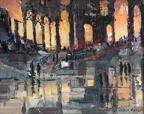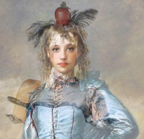
John French Sloan, Photo Portrait, 1891
|
Any one of Sloan's New York paintings would be an intriguing artistic curiosity in its own right. In his own time, they were popular.
But for us today, the body of his work has become a visual history, a way way to peer into the New York of the early 20th century.
Sloan wanted to be known for his skill as a painter and his artistic vision. He did not like to be known for his work as a social commentator.
He was one of a group of 8 painters collectively known as "The Ashcan School," artists who shared an interest in painting daily life in New York at the dawn of the 20th century. But, Sloan did not like the term "Ashcan" at all.
|

Members of the Ashcan School, 1896, Edward Shinn, Robert Henri and John French Sloan |
He felt the term focused attention on social commentary rather than the style of the artistic vision and skill of the individual artists. He wanted his art recognized for his brushwork, color and composition, not as a muckraking voyeur of the lower classes. |
Sloan never thought his politics had anything to do with his art. Although he was a socialist, he insisted his paintings had no social consciousness. He said, "I was never interested in putting propaganda into my paintings, so it annoys me when art historians try to interpret my city life pictures as 'socially conscious.' I saw the everyday life of the people, and on the whole I picked out bits of joy in human life for my subject matter."
|

John French Sloan, Self Portrait 1890
Delaware Art Museum |

The Picnic Grounds, 1906
Whitney Museum of American Art, New York |

The Haymarket, 1907
Brooklyn Museum |

Election Night, 1907
Memorial Art Gallery, University of Rochester
|

Wake of the Ferry, 1907
The Phillips Collection, Washington D.C.
|

Easter Eve, 1907
private collection |
John French Sloan grew up in Philadelphia where he attended Central High School with fellow Ashcan painter William Glackens. Another classmate was Albert C. Barnes who gained great fortune in pharmaceuticals. He consequently became a major art collector, and today, the Barnes Collection Museum in Philadelphia is one of the nation's true artistic treasures.
|

Movies, Five Cents, 1907
private collection |

South Beach Bathers, 1907-08
Walker Art Center, Minneapolis |

Pigeons, 1910
Museum of Fine Arts, Boston |
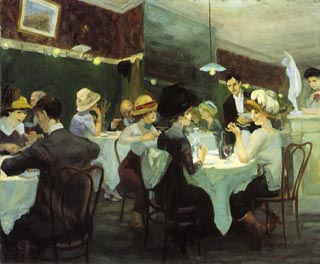
Renganeschi's, Saturday Night, 1912
Art Institute of Chicago
|

Spring Rain, 1912
Delaware Art Museum
|
Sloan joined the Socialist Party in 1910. He became the art editor of the The Masses and provided powerful anti-war and anti-capitalist drawings. Although he was good at it, he wasn't comfortable providing art used as propaganda. He soon resigned, but remained interested in left wing political causes. He was a pacifist and was opposed to America's entering World War I. |
In 1914, Sloan began an 18 year career as teacher at the Art Students League.
He was a respected and feared teacher, known for his practical knowledge and integrity, but also for his caustic tongue. Because he had sold few paintings in his career, he told his students "I have nothing to teach you that will help you to make a living."
His advice to artists was to find joy in the creative process alone.
|

McSorley's Bar, 1912
Detroit Institute of Arts |

Sunday, Women Drying their Hair, 1912
Addison Gallery of American Art,
Phillips Academy, Andover, Massachusetts, |
Beginning in 1919 and every summer thereafter until 1949, Sloan would spend four months each summer painting in Sante Fe, New Mexico. The desert gave him focus and the opportunity to concentrate on form. He and his wife Dolly developed an interest in Native American culture and arts, and became an advocate for Indian artists. |

A Window on the Street, 1912
|

Women's Work, 1912
Cleveland Museum of Art |
He also came to know Diego Rivera whom he called "the one artist on this continent who is in the class of the old masters."
Sloan cofounded The Society of Independent Artists in 1916. He was instrumental in arranging the first showing the work of Diego Rivera and Jose Clemente Orozco in 1920.
As a painter, Sloan labored over his work. While working as an illustrator for the Philadelphia Inquirer, Sloan would lose plum reporting assignments because he couldn't render a sketch as quickly as his colleague and friend William Glackens.
|

Wet Night, Washington Square, 1928
Delaware Art Museum |
Robert Henri used to describe Sloan as not only being slow, but being "the past participle of slow." He was most methodical in both his sketching and painting.
A student said of Sloan's paintings, "he concerned himself with what we call genre: street scenes, restaurant life, paintings of saloons, ferry boats, roof tops, back yards, and so on through a whole catalogue of commonplace subjects." In his diary, Sloan wrote, "I am in the habit of watching every bit of human life I can see about my windows, but I do it so that I am not observed at it ... No insult to the people you are watching to do so unseen."
|

The City from Greenwich Village, 1922 |

Sixth Avenue Elevated at Third Street, 1928 |
By the late 1920's, Sloan could have made a good living from his painting. All he needed to do was continue his now popular paintings of urban life. But, in a manner typical to Sloan, he abandoned the easily successful for a new challenge. Although it displeased his art dealer Charles Kraushaar, he abandoned his earlier style and technique, choosing instead to paint using underpainting and glazing used by the old masters. Instead of urban scenes, he now painted nudes and portraits, but never achieved the popularity of his early Ashcan works.
Today, we all know the New York of yesterday, the New York shown to us through the paintings of John French Sloan. If Sloan were able to see how he is remembered today, he probably wouldn't like it. But one of the kindnesses of death is one does not get to know how one is remembered.
|
| Back to the top |
| |
|
|
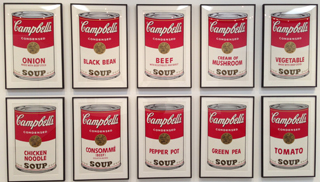
Andy Warhol, "Campbell's Soup" 10 Works - 1968 |
Sonoma County Art Museum:
Andy Warhol to Kara Walker: Picturing the Iconic |
This exhibition begins with this quotation by Jonathan Meades of Intelligent Life Magazine. "Every era suffers a lexicon of invasive usages. Words are as subject to fashion as morals and lapels, politics and popular music. Today's merely tiresome coinage is tomorrow's infuriatingly ubiquitous cliche. The scope of the word 'iconic' suggests that there is nothing that cannot be deemed iconic. Iconic is, in a sense acquired through recent abuse."
|
The exhibition plays with the question, "What it means in pop culture to be 'iconic?'" Included are well known works from the mid 1960's through the present from the graphic arts collection of Jordan D. Schnitzer and the Jordan Schnitzer Family Foundation. Here are some of the show's highlights.
|

Kara Walker, "The Means to an End," A Shadow Drama in Five Acts," 1995 |
Andy Warhol's Campbell Soup Cans caused a sensation in the art world, with the artist becoming an icon himself. Riding this wave of success, he followed with portraits of famous stars such as Elizabeth Taylor, Elvis Presley and Marilyn Monroe. Consequently, Warhol's star rose high. He socialized with the likes of Jackie Kennedy Onasis and Truman Capote, leading to many commissions with wealthy socialites and stars.
Totally unrelated to the kind of iconic success achieved by Warhol, Kara Walker tells the American story ... in black and white. Her striking iconic silhouettes of characters cut from black paper displayed on a white background are striking and challenging. Hilton Als in the 2007 issue of the New Yorker wrote, "“In Walker’s work, slavery is a nightmare from which no American has yet awakened: bondage, ownership, the selling of bodies for power and cash have made twisted figures of blacks and whites alike, leaving us all scarred, hateful, hated, and diminished.”
|

Ed Ruscha, "Mocha Standard" 1969 |
Ed Ruscha's created deadpan representations of Hollywood logos, stylized gas stations and stylized landscapes, all imagery of popular culture in accessible and profound cinematic codes.
Robert Indiana's best known image is the word LOVE in upper-case letters, arranged in a square
|

Robert Indiana, "Four Panel Love" 1972 |
with a tilted letter O. The iconography first appeared in a series of poems originally written in 1958, in which Indiana staked LO and VE on top of one another. It next appeared in a painting with the words "Love is God." The red/green/blue image was then created for a Christmas card for the Museum of Modern Art in 1964. It was put on an eight cent U.S. Postal Service postage stamp in 1973, the first of their regular series of "love stamps."
|

Alexander Calder, "La Memoire Elementaire" 1976 |
Alexander Calder is best known as the originator of the mobile, a kinetic sculpture of delicately balanced components which move in response to air currents. Pictured here are some component shapes.
Roy Lichtenstein was a leading member of a group of artists leading the Pop Art Movement of the 1960's along with Warhol, Jasper Johns, and James Rosenquist.
Lichtenstein believed that all communication is filtered through codes or languages. This is why he chose mechanical reproduction using dots and lines.
Jeff Koons explores ideas of taste, pleasure, celebrity and commerce. He said, "I believe in advertisement and media completely. My art and my personal life are based in it."
|

Roy Lichtenstein, "I Love Liberty" 1982 |

Jeff Koons, "Michael Jackson and Bubbles" 1995 |
As early as the 1950's, Robert Rauschenberg anticipated the pop art movement. He once said, he wanted his work "in the gap between art and life." Today, he is labeled a "neo Dadaist," along with Jasper Johns.
Beginning in 1962, Rauschenberg's paintings began to incorporate objects and images transferred to his canvas by means of a silk screen process.
Barbara Kruger addressed cultural constructions of power, identity and sexuality by overlaying images by pronouns or nouns. She said, "I work with pictures and words because they have the ability to determine who we are and who we aren't."
|
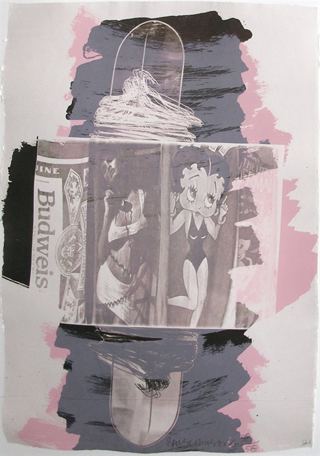
Robert Rauschenberg, "Hollywood Sphinx" 1991
from Illegal Tender LA Series |

Barbara Kruger, "Untitled Fate" 2002 |

Mel Ramos, "Lola Cola" 2004 |
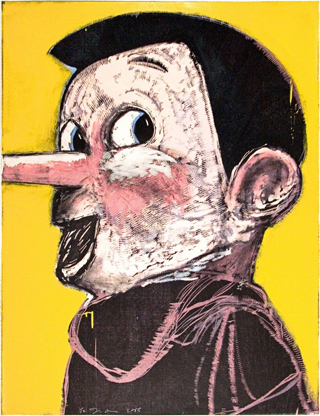
Jim Dine, "Yellow Enamel" 2006 |
Mel Ramos was born in Sacramento where the Crocker Museum held an exhibition of his work in 2012. He was a student of Wayne Thiebaud and is best known as a figurative painter, especially for his female nudes which incorporate realist and abstract elements. He was first recognized in the 1960's along with Andy Warhol and Roy Lichenstein. Reflecting back on his career, he said, "In 1960 I was wallowing in despair when I gave up painting abstract expressionism and painted something that I used to love as a kid, American Super Heroes, and I did a painting of Superman. My life changed, Pop Art was born and I was caught up in the energy of it all."
|
Although Jim Dine's work is synonymous with Pop Art, he doesn't consider himself as such. He said, "I'm not a Pop artist. I'm not part of a movement because I'm too subjective. Pop is concerned with exteriors. I'm concerned with interiors."
|

Jim Riswold, "Mussolini at His Mirror" 2004 |

Jim Riswold, "The Last Supper" 2006 |

Bruce Nauman, "Infrared Outtakes" 2006
(Neck Pull, Opened Eye,
Hands Only, Cockeye Lips) |
Portland ad director Jim Riswold quit advertising to dedicate himself to art after he had been diagnosed with leukemia. Most of his work pokes fun at historically taboo figures, picturing them with everyday items, making them seem childish, small and trifling.
|
Bruce Nauman worked as an assistant for Wayne Thiebaud and taught at the San Francisco Art Institute. Since the mid 80's, he has worked primarily with sculpture and video. He has developed disturbing psychological and physical themes incorporating images of animal and human body parts.
|
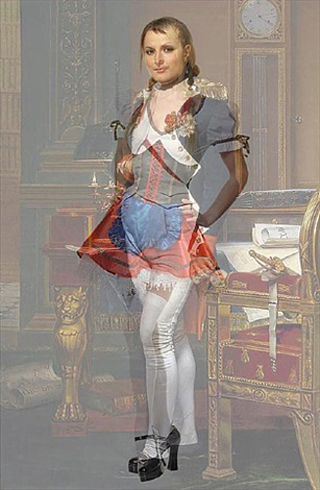
Deborah Oropallo, Napoleon 2007 |

Deborah Oropallo, Bluegirl 2007 |

Shepard Fairey, "Obama Hope Gold" 2009 |
Deborah Oropallo received her MFA degree from Berkeley. Her work is rooted in painting but achieves her effects using camera, computer, printer and paint. She seeks to create a fusion of time and place, form and content. The resulting images possess random distortions. When superimposed images conflict, all kinds of comparisons, contrasts and insights come to mind.
Emerging from the skateboard scene, street activist and artist Shepard Fairey created some posters supporting Barack Obama in 2008. His "Hope" poster was well received. New Yorker art critic Peter Schjeldahl called the poster "the most efficacious American political illustration since "Uncle Sam Want's You." Originally, the poster was made with the word "Progress." The campaign (not associated with the poster) contacted Fairey and requested he issue a new version with the word "Hope."
This exhibition certainly helps wrestle with the question of what "Icon" means in the context of contemporary society and art, but in no way comes close to capturing it. And that is a good thing. Perhaps in the end, one of the roles of art is to encourage us to look at ourselves.
|
| Current exhibition at Museums of Sonoma County through May 24 | Back to the top |

John W. Hilton taking a break from his Calcite Mining activities during WW II |
 |
John W. Hilton did far more than paint. He was a regular contributing writer for Desert Magazine.
In Desert Magazine's September 1945 issue, Hilton tells the tale of his trusted framer, artist William Krehm. Krehm faced a problem shared by many worthy artists, how to get advice from well established painters, and how to gain recognition.
Krehm's solution? He learned the art of framing and made the artists his clients. Along the way, he gained critique and tips for painting and promotion from the likes of Jimmy Swinnerton, Dana Bartlett and Jack Wilkerson Smith. Below is the full text of Hilton's article.
|

Cover Art, Desert Magazine, Sept. 1945 |

William Krehm, Desert Magazine, Sept '45 |
As a fledgling artist, Bill Krehm had little opportunity to meet the top-flight painters from whom he might get help in improving his technique. So he went into the picture framing business—and made such fine frames the successful artists soon were coming to him for their woodwork. It was good strategy—and this month Krehm's work is being shown in one of Los Angeles' best known galleries.
My first meeting with Bill Krehm was the day he and Jimmy Swinnerton stopped at my roadside studio on their way to the desert on a sketching trip. Their car was loaded with painting equipment and their camping outfit.
They were in high spirits. Jimmy, because he loves the desert wilderness and looks forward to every opportunity to return to the field where so much of his fine work has been done. For Krehm, this was to be an adventure of double enjoyment. He had just recovered from a lingering illness that had forced him to give up his work in a war plant, and this was his first real outing in months. |

Jimmy Swinnerton 1966 |
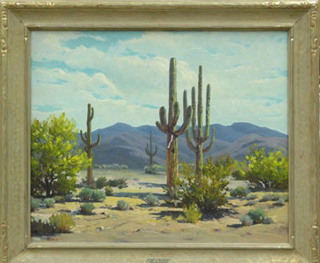
Lure of the Desert, William Krehm
pictured here in a William Krehm frame |

Valley of the Monuments, William Krehm |
And then, he confided to me that Swinnerton had been one of his boyhood idols, and he felt it a rare privilege to be the companion of one who had won so high a place in the world of art. "It's fun to go sketching with Jimmy," he said. And we both realized this was an understatement.
Those trips with James Swinnerton and other top-notch western painters are the climax of a long hard pull along the road of art for William P. Krehm. He has overcome obstacles which would have discouraged and perhaps beaten a less determined man.
|

Agathla Peak, William Krehm
B&W photo in Desert Magazine, Sept '45 |

Gems of the Desert, William Krehm
B&W photo in Desert Magazine, Sept '45 |

The Fallen Tree, William Krehm |
He was born in 1901 in Kansas City, one of a family of eight children. At ten he was getting up every morning at four o'clock to sell papers for the Star and Journal. And after school there were the afternoon editions to sell. This did not leave him much time for his hobby, which was drawing pictures.
He was a great admirer of Swinnerton's cartoons, Little Jimmy, Pinky, Beans and Toby, and he spent hours trying to reproduce these characters. Drawing was not in the curriculum of the public schools in those days and when he stole time from the three "R's" to do his sketches, there was trouble with the teacher.
Bill joined the Navy in 1918 and saw service on the U.S.S. Wisconsin and the U.S.S. Kansas. He later served on the U.S.S. Washington which brought the King and Queen of Belgium and Prince Leopold on their visit to the United States. All through this service he made sketches of the places and scenes that were attractive to him. He never lost sight of his interest in art.
|
After his discharge he returned home for a few months, but was restless. He wanted to see more of the world, and sketch and paint what he saw. He went to St. Louis and got a job on a river boat going to New Orleans. He hoped to sign on a freighter that would take him on a long cruise, but jobs of this sort were hard to find and he failed to get a berth.
He went to Chicago and got a job as a switchboard inspector for Western Electric. In 1926 he went to California to try to ship on a boat from San Francisco. He hoped to see and paint far off places, the islands of the Pacific, China, Japan, India and other parts of the Orient. While waiting for an opportunity to get such a berth, he visited the art galleries in Los Angeles and after studying the paintings of contemporaries decided that he should have more training before he attempted to go out and paint.
He postponed his trip indefinitely and tried to get acquainted with the artists who had produced the paintings he admired. This was not so easy, but Bill was a persistent fellow and he finally hit upon a plan.
|
He decided the way to meet artists was to go into the making of picture frames. He got other work to support him and began doing picture framing on the side. He wasn't satisfied with making ordinary picture frames. His ambition was to produce the sort of frames that would be in demand by the very top-notch painters. This took study and application. It was a roundabout course but he never lost sight of his goal.
Finally in 1930, the depression threw him out of his job and he went into the framing business on a larger scale. This was a blessing in disguise. Soon the artists were getting acquainted with Krehm frames and Bill in turn was getting acquainted with them. He had entry to the best studios and galleries of the country and found many a helping hand among the artists whose paintings he was framing.
|

Cactus in a Desert Landscape, William Krehm |
He studied with Dana Bartlett and later with William T. McDermitt, former art director of the Pullman State College in Washington. It was Jack Wilkinson Smith, however, who really opened his eyes to the finer points of painting. Under his direction Krehm's canvases began to take real life. During this period he made trips into the deserts of Arizona, California and Utah. In them he not only found all the adventure he had longed for, but an unbounded source of painting material. Through all of this period, Bill gives great credit to Jack Wilkinson Smith for his real development and progress.
His paintings were beginning to sell but few who bought them had ever heard of him. This is the problem faced by most aspiring artists and it probably will always be the same. He continued making better frames.
If his paintings were not famous, his frames were well known among the good artists in the West. Most of these painters in turn were willing to lend a helping hand in the way of suggestion and criticism and Bill was humble enough to take these suggestions and criticisms and profit by them.
|

Hiker's Sanctuary, William Krehm |
In 1937 William Krehm the budding artist and top-notch frame maker met James Swinnerton his childhood idol who in the meantime had taken up serious painting and was bringing the desert into the galleries and homes all over the United States. This meeting must have been a distinct thrill even though at first their common interest was limited to picture frames. It was not long before a friendship developed, for Jimmy is that sort of a person. The friendship led to sketching trips and informal instruction that were invaluable to Krehm. Swinnerton with his background of 40 years of desert painting could see a great deal more in the desert than most artists and he was willing and eager to teach his friend how to see these things too, and to put them on canvas.
His pictures were exhibited at the San Francisco fair, and have been hung in a number of the state fairs and in lesser shows. Art critics who saw these few paintings have been more than favorable in their comments. Now Krehm has his real chance.
|
The Biltmore Art salon has invited him to present an exclusive exhibit of his most recent work during the current month of August. I have seen about half of the canvases that will be on display in this show and it is my belief that they will stand up with other work shown in this discriminating gallery.
James Swinnerton says of him: "For years Bill Krehm framed the paintings of other artists. He was compelled in many instances to handle work that was not worthy of a really fine frame. On the other hand, some paintings that passed through his adept hands were an inspiration, and he sought faithfully to make the frame worthy of the picture. His previous fine artsmanship fits him to do a finished job of actual brushmanship, and he has a fine sensitive eye for color. Most of all, he has the aptitude for hard work at the easel, and that is the only way to learn and keep on learning to the end of our days."
It is my opinion that after the Biltmore show, thousands of other art-minded people in the West will be saying other complimentary things about Bill Krehm.
|
| John W. Hilton's page | Jimmy Swinnerton's page | Back to the top |
| What's showing in Bodega Bay? |
 |
Bodega Bay Heritage Gallery
1785 Coast Highway One, Bodega Bay, CA 94923, 707-875-2911 | Map & Location
Celebrating Early California Art
- original paintings by famous artists of the past - and local artists
Now on Exhibit ... "The Southwest"
|

"Composed by the Ocean"
Joshua Meador |
 |
The Ren Brown Collection
A show Celebrating 25 years in Bodega Bay
http://www.renbrown.com | Back to the Top
|

|
What's showing nearby?
in Sonoma, Napa & Marin Counties |
 |
IN DUNCANS MILLS Christopher Queen Galleries
3 miles east of Hwy 1 on Hwy 116 on the Russian River
"The Traveling Painters" Bart Walker, Paul Kratter, & Sergio Lopez
http://www.christopherqueengallery.com |707-865-1318| Back to the Top |
 |
 |
IN DUNCANS MILLS Quercia Gallery
Hours: 11am-5pm, Thur - Mon (707) 865-0243
http://www.quercia-gallery.com | Back to the Top
|
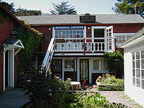 |
 |
NOW IN SANTA ROSA Calabi Gallery | http://www.calabigallery.com 888
456 Tenth Street, Santa Rosa, CA 95401 | email: info@calabigallery.com | 707-781-7070
Famed master conservator Dennis Calabi brings his rare knowledge and experience
to present a tasteful and eclectic array of primarily 20th century artwork.
http://www.calabigallery.com | Back to the Top |

Easton, Crustacean Dancing Dream, American Alabaster |
 |
IN Santa Rosa The Annex Galleries
specializing in 19th, 20th, and 21st century American and European fine prints
The Annex Galleries is a member of the International Fine Print Dealers Association (IFPDA).
http://www.AnnexGalleries.com | Back to the Top |
 |
IN GRATON Graton Gallery
http://www.gratongallery.com
Graton Gallery | (707) 829-8912 | artshow@gratongallery.com
9048 Graton Road, Graton CA 95444 | Open Wednesday ~ Saturday 10:30 to 6, Sunday 10:30 to 4
|
 |
 |
IN BODEGA Bodega Landmark Gallery Collection
17255 Bodega Highway Bodega, California USA 94922 Phone 707 876 3477
http://www.artbodega.com | Lorenzo@ArtBodega.com | Back to the Top |
 |
IN Healdsburg Hammerfriar Gallery
http://www.hammerfriar.com
(707) 473-9600 | Jill@hammerfriar.com
132 Mill Street, Healdsburg, CA 95448 | Open Tues - Fri 10 to 6, Sat 10 - 5, Sun 12 - 4
|
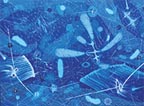 |
 |
IN PETALUMA Vintage Bank Antiques
Vintage Bank Antiques is located in Historic Downtown Petaluma, corner of Western Avenue and Petaluma Blvd. It is listed on the National Register of Historic Places. Warren Davis and the rest of the team at Vintage Bank Antiques has assembled a spectacular inventory of paintings. From the 18th Century to Contemporary Artists. We have paintings to suit every price point and collector level.
If you have a painting for sale, please consider Vintage Bank Antiques. Contact Warren Davis directly at WarrenDavisPaintings@yahoo.com, 101 Petaluma Blvd. North, Petaluma, CA 94952, ph: 707.769.3097
http://vintagebankantiques.com | Back to the Top |
 |
IN PETALUMA Petaluma Art Center
"... to celebrate local artists and their contributions and involve the whole community
|

|

Lee Youngman |
IN CALISTOGA the Lee Youngman Gallery
Featuring the work of contemporary painter Paul Youngman,
and the works of famed painter, Ralph Love (1907-1992)
http://www.leeyoungmangalleries.com | Back to the Top
Left ... Lee Youngman, Right ... Paul Youngman |

Paul Youngman |
| Links to current museum exhibits relevant to Early California Art |
| The Greater Bay Area |
The Walt Disney Family Museum
This museum tells Walt's story from the early days.
(on the Parade Grounds) 104 Montgomery Street,
The Presidio of San Francisco, CA 94129
-- view location on Google Maps -- |
 |
San Francisco
de Young Museum
Botticelli to Braque: Masterpieces from the National Galleries of Scotland
read our April Newsletter Article
about this superb exhibition!
through May 31
|
 |
San Francisco
California Historical Society
Yosemite: A Storied Landscape
through Dec 6, 2015
|
 |
San Francisco
Legion of Honor
Permanent European
and Impressionist Paintings
|
 |
San Francisco
Contemporary Jewish Museum
|
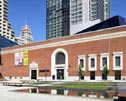 |
Oakland
Oakland Museum of California
-- ongoing Gallery of California Art
-showcasing over 800 works from the OMCA's collection
|
 |
San Francisco
SFMOMA
Now ... More Open than ever ...
see our website
but closed for renovations
http://www.sfmoma.org/our_expansion |
 |
Santa Rosa
The Museums of Sonoma County
Now two buildings, one for History, one for Fine Art
"Andy Warhol to Kara Walker,
Picturing the Iconic"
through May 24
|
 |
Santa Rosa
Charles M. Schultz Museum
"Peanuts in Wonderland" through April 26
|
 |
Moraga
Hearst Art Gallery
Visual Language: Mystery and Meaning, work by
-SMC Museum of Art's Andy Warhol Collection
April 19 - June 14
-William Keith April 19 - June 21
|
 |
Sonoma
Mission San Francisco de Solano Museum
featuring the famed watercolor paintings
of the California Missions
by Christian Jorgensen |
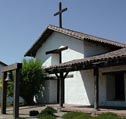 |
Sonoma
Sonoma Valley Museum of Art
551 Broadway, Sonoma CA 954
(707) 939-7862 |
 |
Ukiah
Grace Hudson Museum
The Art of Sustainability, through May 17
Modern Twist:
Contemporary Japanese Bamboo Art
May 30 - Aug 30
http://www.gracehudsonmuseum.org |
 |
Bolinas
Bolinas Museum
featuring their permanent collection,
including Ludmilla and Thadeus Welch,
Arthur William Best, Jack Wisby,
Russell Chatham, Alfred Farnsworth. |
 |
Walnut Creek
The Bedford Gallery, Lesher
Center for the Arts |
 |
San Jose
San Jose Museum of Art
approximately 2,000 20th & 21st
century artworks including paintings, sculpture,
new media, photography, drawings, prints, and artist books. |
 |
Monterey
Monterey Museum of Art
Ongoing exhibitions ...
-Iconic Masterpieces of Early California Painting
-S.C. Yuan from the Museum’s Permanent Collection
http://www.montereyart.org |
 |
Palo Alto
Cantor Art Center at Stanford University
Rodin! The Complete Stanford Collection |
 |
Sacramento 44444444
Crocker Art Museum
Armin Hanson: The Artful Voyage
Jun 28 - Oct 11
& their marvelous Permanent Collection |
 |
Sacramento
Capitol Museum
Governor's Portrait Gallery
Permanent Exhibits
(including one of our galllery's favorite artists,
Robert Rishell's portrait of Gov. Ronald Reagan) |
 |
Stockton's Treasure!
The Haggin Museum!
-Largest exhibition of Albert Beirstadt paintings anywhere,
plus the works of Joseph Christian Leyendecker,
Norman Rockwell's mentor.
see our Newsletter article, April 2011
|
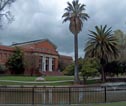 |
|
|
| Southern California (and Arizona) |
Los Angeles
Los Angeles Museum of Art
Art of the Americas, Level 3:
Artworks of paintings and sculptures
from the colonial period to World War II—
a survey of of art and culture
& "Levitated Mass" |
 |
Irvine
The Irvine Museum
California: This Golden Land of Promise
through May 21 |
 |
Santa Barbara
The Santa Barbara Museum of Art
Degas to Chagall:
Important Loans from
The Armand Hammer Foundation
|
 |
Palm Springs
Palm Springs Art Museum
Permanent Collection
American 19th century Landscape Painting
|
 |
San Diego
San Diego Museum of Art
Permanent Collection |
 |
Pasadena
The Huntington Library
American Art Collection
Paintings by John Singer Sargent,
Edward Hopper, Robert Henri,
Albert Bierstadt, Thomas Moran,
William Keith, Mary Cassatt,
Thomas Hart Benton and many more. |
 |
Pasadena
Norton Simon Museum
-an Impressive Permanent collection,
European impressionist and post impressionist paintings
See our newsletter from March 2014 |
 |
Pasadena
Pasadena Museum of California Art
Armin Hansen: The Artful Voyage
Through May 31 |
 |
Prescott, AZ
Phippen Museum
Architecture in Art
through July 13
|
 |
|
|
| & Beyond |
Seattle, WA
Seattle Art Museum |
 |
Portland, OR
Portland Art Museum
Permanent Collection: American Art |
 |
Washington D.C.
The Renwick Gallery
Permanent ... Grand Salon Paintings
from the Smithsonian American Art Museum |
 |
Chicago, IL
Art Institute of Chicago
Permanent collection:
the Impressionists |
 |
Cedar Rapids, IA
The Cedar Rapids Museum of Art
Grant Wood: In Focus
is an ongoing permanent collection exhibition. |
 |
Bentonville, AR
Crystal Bridges
Museum of American Art
|
 |
Washington D.C.
The National Gallery
Permanent collection
American Paintings |
 |
Philadelphia , PA
The Philadelphia Museum of Art |
 |
Philadelphia , PA
Barnes Foundation, Philadelphia Campus |
 |
Brooklyn, NY
The Brooklyn Museum
American Art
Permanent Collection |
 |
New York , NY
The Whitney Museum of American Art
The largest selection of works by Edward Hopper |
 |
|
|


















































































































